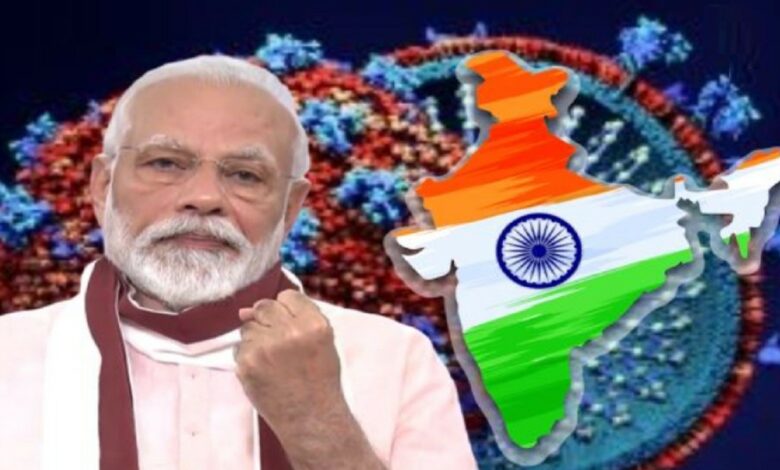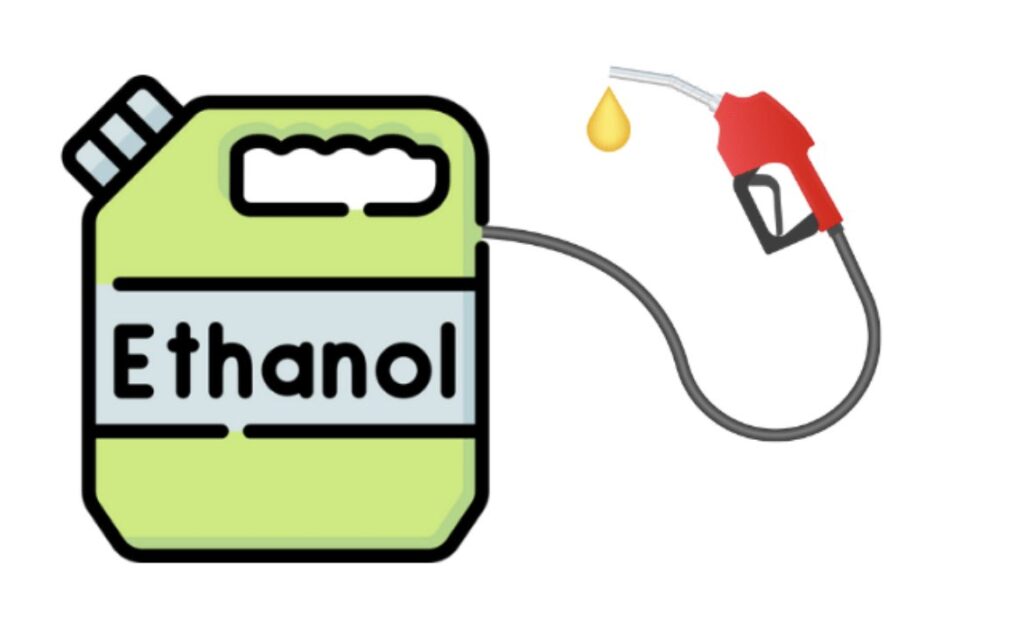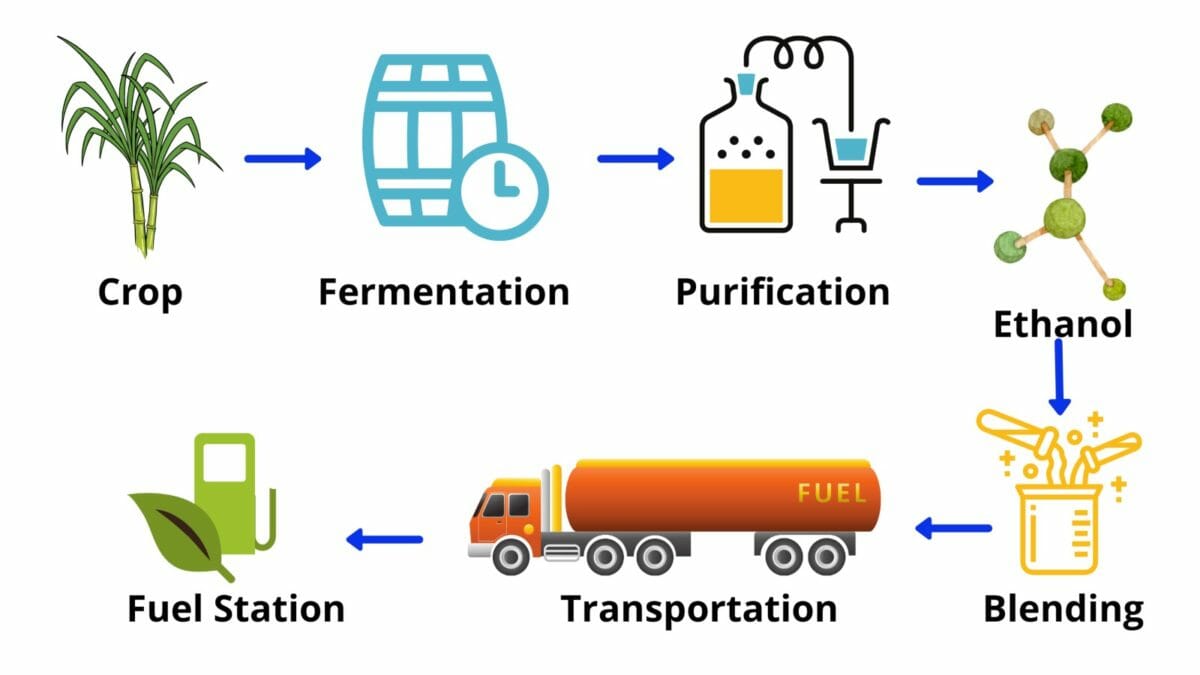10% Ethanol Blending Goal Achieved

India accomplished the 10% Ethanol Blending Goal.
India had achieved the goal of Ethanol Blending, which was set for November 2022.
India had achieved its target five months before. The future goal for the further Ethanol Blending is set to be 20% during the year 2025 – 2026.

On the occasion of the world environment day on 5th June, Prime Minister Narendra Modi set a target of reducing 20% ethanol Blending in Petrol by 2025.
Now let’s have a look at this in a bit of detail.
Ethanol is one of the principal biofuels which the Fermentation of sugars naturally produces by Yeast or via Petrochemical processes such as ethylene hydration.
In other words, Ethanol is a biofuel obtained preliminary from sugarcane, food grains such as wheat, and broken Rice.
The Ethanol Blending Programme (EBP) aims to reduce the Country’s dependence on Crude oil imports, cutting carbon emissions and boosting farmers’ income. Ethanol has a higher octane number than gasoline, improving the petrol Octane number.
The Government of India has advanced the target for 20% ethanol Blending in Petrol (also called E20) to 2025 from 2030.
As we have already discussed, Ethanol is one of the Principal biofuels, so it is essential to know about it. Biofuels may be said, liquid or gaseous.
- Solid:- Wood, dried plant material, and manure
- Liquid:- Bioethanol and Biodiesel
- Gaseous:- Biogas
These can be used to replace in addition to diesel, Petrol, or their fossil fuels for transport, stationary, portable, and other applications. Also, who can use them to generate heat and electricity?
That’s why our Prime Minister, Mr. Narendra Modi, had recently discussed Flex Fuel, which we would meditate on.
Statistically, India is the second-largest consumer of petroleum in the world. And it is estimated that by the end of 2023, we’ll become the third-largest. This is something which is a matter of issue. Because of this, we need a kind of fuel through which first our import dependence would become lesser and through which the carbon emissions would also reduce.

Ethanol is a sort of alcohol, and various types of alcohol have been used to fuel engines throughout human history. So using Ethanol in IC and petrol engines will not be dramatically different; it’s not something new or revolutionary. But everybody’s interested in Ethanol suddenly is because who can create Ethanol from biomass, which means crops like corn or sugarcane l, etc., can be used to generate what is effectively something you can burn in your car and power it and go distances.
Steps in production of Ethanol as a vehicle fuel.
- Step 1:- Fermentation
Ethanol generates from sugarcane or wastage of food. The process of Ethanol Blending starts with Fermentation.
In this process, the sugar is broken down.
There are various forms of sugar, including glucose, fructose, and sucrose. Through the process of Fermentation, the sugar is broken down and converted into cellular energy.

- Step 2:- Purification
After the process of Fermentation in which sugar is broken down, the next step is purifying this Cellular energy.
- Step 3:- Blending
Once the process of purification gets done, we get our Ethanol. This Ethanol is mixed with the Petrol and then distributed to the Petrol Pumps.
Importance
- Reduce Dependency
Ethanol Blending With Petrol reduces the dependency of our Country on other nations.
Today India imports 85 per cent of its oil from other nations. The process of Ethanol Blending with Petrol will reduce trade with India with other Countries for the Import of Oil.
- Save Money
As we have discussed above, Ethanol Blending with Petrol will reduce our dependence on other countries for the Import of Oil. Subsequently, it will reduce the amount the Government spends on the Import of Oil.
As the Government cut down its import of OilOil. India would be able to save a lot due to this Cut.
- Less Pollution
The use of Petrol and diesel causes a lot of pollution. Its use releases harmful gasses, including Carbon Dioxide, methane, and many more.

Ethanol is eco-friendly and will contribute to the environment’s wellbeing.
Disadvantage
Everything has its two phrases. If Ethanol is good, it subsequently has some harmful effects as well.
- Shortage of That used well
There are some case studies where the use and increase of Ethanol as a fuel for automotive applications has caused a lot of lands that are used for food crops to now be used for fuel crops causing an artificial shortage in the availability of that food source.
- Risk of Hunger
As we have discussed above, When we use a lot of crops for the production of Ethanol, this will create a shortage of Crops, and this will further lead to a situation where hunger will be adversely affected and lead to a Risk of Hunder.
Conclusion
However, India is very far away from this situation, so while that is a genuine issue, it’s something that we can deal with later. And in time, technology has also moved on where Ethanol can be made from waste biomass rather than active biomass, which means the parts of the plant that we use for food are not the parts of the plant that can be used to generate the Ethanol anymore.
This means you can double leverage the same land to create Ethanol from one part of the plant and find another aspect to eat, so it’s not that much of a crisis.
In India, we have got so far Ethanol mixes that range between 5 per cent and 8 per cent, and they’re officially listed as E10, and the E designation means ethanol mix petrol. You’ve got various kinds of things from E10, 10 per cent, E25, which should be self-explanatory, E85 in some countries E100 as well.
The Country at the forefront of the ethanol revolution, as it were, is Brazil, which ran into fuel issues many years ago, and for decades, they have run all kinds of mixes of Ethanol. Today they are on some very, very high level.
Brazil is probably the world’s most outstanding market for flex-fuel vehicles, which can run not just pure Ethanol but all kinds of mixes with Petrol quite happily because the systems are designed to adapt to whatever the fuel is.

And we need this adaptation to happen because Ethanol as a fuel is a little bit different from Petrol.
First of all, the amount of Energy in Ethanol is slightly lower than in Petrol, litre to litre. You have to burn more Ethanol to activate the same result.
The other thing about Ethanol is that Ethanol contains oxygen molecules inside the compound, which means that when it enters the combustion chamber, it brings oxygen with it, so you don’t need so much oxygen.
So if a car were to run a 14.5: 1 air-fuel mix, an ethanol engine might only run 12.6: 1, but the flip side is because it brings its oxygen; Ethanol is quite happy to use Ethanol.
But the big reason to use Ethanol is, especially for India. We import a lot of our Petrol and diesel, and if we can replace even 10 per cent or 20 per cent of that with Ethanol, we save a significant amount on the import bill, and that’s why the Government is so excited about it.
And what the Government has done most recently is that while they have always had the policy to increase the amount of Ethanol in Petrol that you buy, they have moved the datelines forward; just like they did with BS6, and that means that the manufacturers are going to struggle again to meet an entirely new requirement.
There is some resistance to this because the industry already says that the five-year insurance law caused a hiccup, the ABS law caused a hiccup, the airbags laws caused a hiccup, and the BS6 arrival; so early and so fast caused the hiccup.
The Government has already gone all the work to put these things stability, and now the Government is saying to adopt Ethanol and an accelerated schedule. That’s where the resistance is coming from.
But the biggest issue with the Ethanol is people worrying about what happens to their engines, which should have been running pure Petrol or E19, and now suddenly, they’re being required to run E25 in a little as five or seven years from now. And the Answer to that is most vehicles already make accommodations for Ethanol.
One accommodation that needs to be made is Ethanol is more corrosive than Petrol, and there are chances that it will eat things like the inner plastic liners of your fuel tank and various rubber seals and gaskets that it encounters along the way. There is a chance that Ethanol will corrode these things.
But this is true more or less entirely about older vehicles rather than more recent ones. And the thumb rule seems to say anything. manufactured after 2001 should be able to run Ethanol without too much trouble.

As we have already discussed, the other adaptation that needs to be made is that Ethanol evaporates slower. It contains less energy than Petrol, and when you mix it, the properties of the engine change, the fuel injection system, etc., have to be able to adapt to this.
The evaporation idea means that the fuel injector might have to have bigger holes because you need more Ethanol in the combination chamber, whereas the fuel
The injection system might have to put less air because there’s Ethanol in the combustion chamber. Butt, most systems today are flexible enough to adapt to these changes, especially up to the level that the Indian Government is looking at, which is E25.
It’s when you cross E25 and put more Ethanol into combustion engines that genuinely need flex-fuel vehicles, which can prefer Ethanol to Petrol, as it were, and be able to run well in that condition.
There were some concerns initially that ethanol engines were harder to start if you ran Ethanol at freezing temperatures. Those engines used to have traditionally a tiny petrol tank, which who would use to create the car.
No longer is the case today. Technology has moved on, and most cars that run E5, E10, up to E25 don’t have any complicated starting problems either; technology has also solved those issues.
So as a user, it will be an interruption for the manufacturers more than for you. If you bought a car in the very recent past or a motorcycle in the most recent history, I don’t think you’ll face any challenge when you go to E25 in seven or eight years, and manufacturers will adapt their vehicles to run E25.
So if you are buying a vehicle five or six years from now, it will be E25. And that’s all you need to know about Ethanol.
How much Ethanol will be required to achieve the target of 20 per cent?
It is an ambitious plan because so far, after all these years, India manages only 9 per cent of Ethanol Blending. Currently, we are at 10%, and there’s been a significant jump from last year. Last year we were just at 5 per cent.
For 10% we need about 3500 million litres of Ethanol and to reach a target of 20 per cent we would need about three times that because the petrol sales will also go up so from current three and a half thousand, we are talking about three times that so which means about say 10,000 or a litre more than that.
It’s all about having Ethanol available in the Country, so manufacturing has to go up, and that’s what India is working on. We are very hopeful that the manufacturing will go up.
How much will sugar-based Ethanol and Non-Sugar found Ethanol?
Currently, most of the Ethanol is sugar-based. All of these 3,500 million litres, which we have discussed before, around 300 billion are non-Sugar based, i.e., grain-based.
As we move along, we have to reach a stage where it becomes 50 per cent. Fifty percent would be sugar-based, and 50 percent would be grain-based. This would happen because the sugar will cause a Blackout. The total sugar production in our country is not stated to grow, and that’s not the objective of the Government because the Government wants to reduce the sugar production in the Country. We already have a surplus, and we want to produce more from grain as in grain; we recently decided to accept maize. Earlier maize-based Ethanol was not obtained, so that is very major which has been taken, and we hope that some farmers will shift to growing maize.
This is important because crops are considered a renewable energy source, so when I run out of a corn crop, I can grow more corn. When the sugarcane crop is done, I can grow more sugarcane and, therefore, keep generating a more prominent source of Ethanol.
There are various options for us, including surplus rice, so who also used Rice, maize, some damaged rice, and other grains, but mostly preference would be given to Rice along with maize.
How much would the Government Save?
If we look at the amount of money which we are paying is about 15,000 crore. Now the road is 10 million, so multiplying by 10 Indian rupees.
Currently, for procurement of this amount of Ethanol, this will go to 50,000 crore Indian Rupees, so again multiply by ten, and we have a million.
Hence vast amounts of money will be saved by the Government, and part of that money would ultimately flow to the farmers because they are the ones producing the food grains and the sugarcane which are going to be used in Ethanol. At the same time, some money also goes to the owners of these industries.
Suppose we talk about a few investments, the total investment required to get this additional production capacity into the countries. The current production capacity is about 7000 million litres per annum.
Edited by Prakriti Arora




